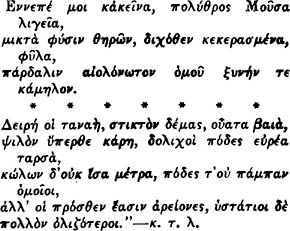). It used to be sent as a present from Nubia to the kings of Persi a, as in later days it was sent to the Arab princes, to the first khalifs of the house of Abbas, and to the Walis of Misr.…The origin of the giraffe has given rise to numerous discussions. It has been noticed that the panther of Nubia attains a great size, whilst the camel of that country is of low stature, with short legs,” &c., &c.— Mas’udi, iii. 3-5.
c. 1253.—“Entre les autres joiaus que il (le Vieil de la Montagne) envoia au Roy, li envoia un oliphant de cristal mout bien fait, et une beste que l’on appelle orafle, de cristal aussi.”—Joinville, ed. de Wailly, 250.
1271.—“In the month of Jumada II. a female giraffe in the Castle of the Hill (at Cairo) gave birth to a young one, which was nursed by a cow.”—Makrizi (by Quatremère), i. pt. 2, 106.
1298.—“Mais bien ont giraffes assez qui naissent en leur pays.”—Marco Polo, Pauthier’s ed., p. 701.
1336.—“Vidi in Kadro (Cairo) animal geraffan nomine, in anteriori parte multum elevatum, longissimum collum habens, ita ut de tecto domus communis altitudinis comedere possit. Retro ita demissum est ut dorsum ejus manu hominis tangi possit. Non est ferox animal, sed ad modum jumenti pacificum, colore albo et rubeo pellem habens ordinatissime decoratam.”— Gul. de Boldensele, 248-249.
1384.—“Ora racconteremo della giraffa che bestia ella è. La giraffa è fatta quasi come lo struzzolo, salvo che l’imbusto suo non ha penne (‘just like an ostrich, except that it has no feathers on its body’!) anzi ha lana branchissima…ella è veramente a vedere una cosa molto contraffatta.”—Simone Sigoli, V. al Monte Sinai, 182.
1404.—“When the ambassadors arrived in the city of Khoi, they found in it an ambassador, whom the Sultan of Babylon had sent to Timour Bey.…He had also with him 6 rare birds and a beast called jornufa…” (then follows a very good description).—Clavijo, by Markham, pp. 86-87.
c. 1430.—“Item, I have also been in Lesser India, which is a fine Kingdom. The capital is called Dily. In this country are many elephants, and animals called surnasa (for surnafa), which is like a stag, but is a tall animal and has a long neck, 4 fathoms in length or longer.”—Schiltberger, Hak. Soc. 47.
1471.—“After this was brought foorthe a giraffa, which they call Girnaffa, a beaste as long legged as a great horse, or rather more; but the hinder legges are halfe a foote shorter than the former,” &c. (The Italian in Ramusio, ii. f. 102, has “vna Zirapha, la quale essi chiamano Zirnapha ouer Giraffa.”)—Josafa Barbaro, in Venetians in Persia, Hak. Soc. 54.
1554.—“Il ne fut onc que les grands seigneurs quelques barbares qu’ilz aient esté, n’aimassent qu’on leurs presentast les bestes d’estranges pais. Aussi en auons veu plusieurs au chasteau du Caire…entre lesquelles est celle qu’ilz nomment vulgairement Zurnapa.”—P. Belon, f. 118. It is remarkable to find Belon adopting this Persian form in Egypt.
GIRJA, s. This is a word for a Christian church, commonly used on the Bengal side of India, from Port. igreja, itself a corruption of ecclesia. Khafi Khan (c. 1720) speaking of the Portuguese at Hoogly, says they called their places of worship Kalisa (Elliot, vii. 211). No doubt Kalisa, as well as igreja, is a form of ecclesia, but the superficial resemblance is small, so it may be suspected that the Musulman writer was speaking from book-knowledge only.
1885.—“It is related that a certain Maulví, celebrated for the power of his curses, was called upon by his fellow religionists to curse a certain church built by the English in close proximity to a Masjid. Anxious to stand well with them, and at the same time not to offend his English rulers, he got out of the difficulty by cursing the building thus:The word is also in use in the Indian Archipelago:
‘Gir ja ghar! Gir ja ghar! Gir ja!’ (i.e.) ‘Fall down, house! Fall down, house! Fall down!’ or simply
‘Church-house! Church-house! Church!’ ” —W. J. D’Gruyther, in Panjab Notes and Queries, ii. 125.
1885.—“The village (of Wai in the Moluccas) is laid out in rectangular plots.…One of its chief edifices is the Gredja, whose grandeur quite overwhelmed us; for it is far more elaborately decorated than many a rural parish church at home.”—H. O. Forbes, A Naturalist’s Wanderings, p. 294.
| Previous chapter/page | Back | Home | Email this | Search | Discuss | Bookmark | Next chapter |
See our FAQ for more details.

